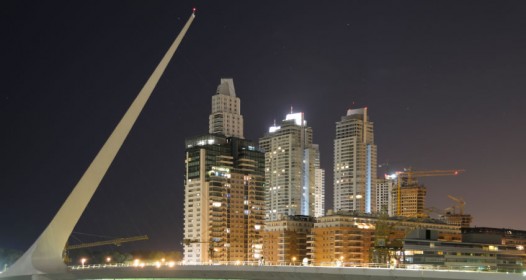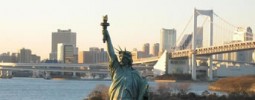Beunos Aires is the capital and largest city of Argentina. It is situated on the southern shore of Rio de la Plata, on the south eastern coast of the South American continent. The Argentine capital has been the political center since the beginning. About 3 million people live in Buenos Aires.
Salta is the capital city of the Salta Province located in the northwest of Argentina. The city is situated in the Lerma Valley at 3800 ft. above sea level, and at the foothills of the Andes mountains. The city’s location is perfect to explore its region. As of latest measurement Salta has a population of 500 thousand people making it Argentina’s eighth largest city.
The center of the city is small enough to be explored on foot. Plaza 9 de Julio is the city center, here you can also find the Cathedral established in the 1850s and also the Cabildo. In the east of the center, which can be reached by cable car is the Cerro San Bernardo from where you can overlook the city, especially at night and sunrise this is a beautiful view.
When enjoying your time in Salta, and looking for a short excursion outside the city, try visiting the small suburb San Lorenzo. Stroll around in the parks, enjoy the forest smell while hiking in one of the many trails. Rent a horse to ride up the hill and and behold the fantastic Salta city views. Don’t forget to walk around in the neighborhood to see and photograph the colonial style houses the rich live in. Furthermore there are several other excursions being held within city limits including local sightseeing with culture and history.
Travelers to Mendoza need a valid passport. American citizens don’t require a visa for tourist stays up to 90 days. The best time to visit the city is from March to May and August to November. These months the temperatures aren’t too high and there is little rain. Mendoza also provides outdoor possibilities in the Sierras mountains.
Mendoza is the capital city of the Mendoza Province in the country of Argentina. The city is situated in the north central part of the province, surrounded by foothills and high plains. As of latest measurement the city has a population of about 900 thousand people, making Greater Mendoza the 4th largest census metropolitan area in Argentina.
The city of Mendoza was originally found in 1561, since then a lot of historical buildings and place of interests have established around city center. A few of the tourist sightseeing include the Ruinas de San Francisco mission in the Ciadad Vieja, the Parque San Martin and the Museo Fundacional. When feeling like shopping during weekend, visit Plaza Espana where artisans markets are being held. If you prefer relaxing and enjoying with a drink choose to sit on the sidewalk terraces on Avenida San Martin.
As Mendoza is worldwide famous for its Argentinian wine industry it’s recommended to visit one of the many wineries just outside city center. Fine wine tasting, a tour on the farms and wine chambers are included for a day of fun, plus a chance to buy wine straight of the producer. Other tourist attractions around Mendoza include skiing in the los Penitentes, exploring mountains in Uspallata or visiting Aconcagua on the border of Chile to have a look at South America‘s highest mountain the Cerro Aconcagua.
Travelers to Mendoza need a valid passport. American citizens don’t require a visa for tourist stays up to 90 days. The best time to visit the city is from March to May and August to November. These months the temperatures aren’t too high and there is little rain. Mendoza also provides outdoor possibilities in the Sierras mountains.
Cordoba is the second largest city in Argentina and the capital of Cordoba Province in the northwest. The city was founded in 1573 and named after the city in Spain. It was one of the first Spanish colonial cities. The city is surrounded by valleys of three mountain groups. It has a population of 1.3 million or more people. Cordoba is nicknamed La Docta or roughly “Learned Lady” because of the many universities and students.
Cordoba is a lively city with a fascinating mix of new and old. It mixes colonial architecture with modern buildings. There are many historical monuments, foremost buildings of the Roman Catholic Church. The Jesuit Block, a group of buildings dated from the 17th century, is declared as a World Heritage Site. This site includes the Montserrat School and the colonial university campus. The city is full of churches, palaces, monuments, museums and theaters. The city also has four excellent municipal galleries.
Cordoba has just as other large cities many shopping centers and a vibrant nightlife, although it is somewhat quiet during university holidays. The city has a public transport system with buses, trolleybuses and taxis. The Plaza San Martin square is considered to be the center of the city. Here you will find the Jesuit Cathedral, the colonial government house the Cabildo and the Jesuit Block. West of the city the famous holiday center Villa Carlos Paz is located near the San Roque dam which provides the city with potable water.
Travelers to Cordoba need a valid passport. American citizens don’t require a visa for tourist stays up to 90 days. The best time to visit the city is from March to May and August to November. These months the temperatures aren’t too high and there is little rain. Cordoba also provides outdoor possibilities in the Sierras mountains.
Esquel is a town in the Argentine Patagonia in the northwest of the province of Chubut. It was only founded in 1906 and is now the main livestock and commercial center of the region. Esquel got its name from the language of Mapuche, from a term meaning ‘quaking bog’ or ‘place of the thistles’. It is located is located by the Esquel Stream and surrounded by the mountains La Zeta, La Cruz, Cerro 21 and La Hoya. La Hoya is a popular ski resort.
For most travelers Esquel is just a quick stop over on their way to the Los Alerces National Park, 31 miles northwest of the city, and other recreation areas. The city is at the southern end of the narrow-gauge train line of The Old Patagonian Express or La Trochita. This train now takes tourists in the summer from Esquel to the volcano and settlement Nahuel Pan, and the other way around.
Esquel is foremost an easy-going and exceeding friendly base camp for activities in the surroundings areas. Possible activities are path hiking, river rafting, fly fishing, horse riding, tours around ranches, climbing and lake circuits. It can be the perfect place to chill for a few days as it rests on a green mountain range valley. The city has two museums, different restaurants and hotels.
Travelers to Esquel need a valid passport. American citizens don’t require a visa for stays up to 90 days. The weather can be pretty cold. The best time to travel depends on your purpose. For other purposes than skiing on La Hoya the best time is from December till March, as there is little rain and temperatures are around 50 Fahrenheit.









